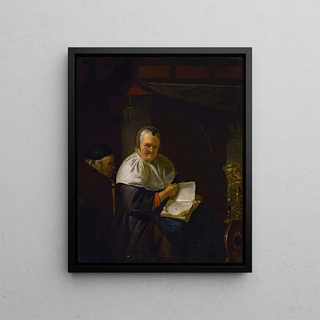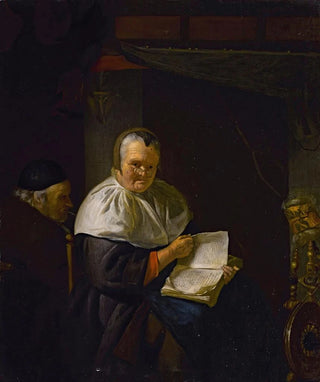Art print | Interior with a woman reading near a spinning wheel and a man smoking - Antoine van Dyck


View from behind

Frame (optional)
The artwork "Interior with a woman reading near a spinning wheel and a man smoking" by Antoine van Dyck offers a window into an intimate and warm world. This painting, capturing a moment of domestic life, evokes a peaceful and contemplative atmosphere. The scene, where natural light delicately filters through the windows, highlights the subtle gestures of the characters. The woman, absorbed in her reading, and the man, whose gaze is lost in the smoke of his pipe, seem frozen in a moment of serenity. This piece does not merely depict a simple genre scene; it invites the viewer to immerse themselves in the characters' intimacy, to share their daily life, and to feel the emotion emanating from this instant.
Style and uniqueness of the work
Van Dyck's style is distinguished by his attention to detail and masterful use of light. In "Interior with a woman reading near a spinning wheel and a man smoking," the textures of the clothing, the softness of the faces, and the ambient luminosity are rendered with remarkable precision. The color palette, dominated by warm and earthy tones, helps create a welcoming atmosphere. The elements of the composition, such as the spinning wheel and the books, are not mere accessories but symbols of daily life and culture. The way Van Dyck juxtaposes human figures with everyday objects demonstrates his skill in transforming ordinary scenes into captivating works of art. Every detail, every shadow, every reflection seems to tell a story, making the piece even more immersive and engaging.
The artist and his influence
Antoine van Dyck, one of the masters of 17th-century Flemish painting, left an indelible mark on art history. A pupil of Rubens, he developed a style that is uniquely his own, combining baroque grandeur with an intimate sensitivity. Van Dyck was able to capture the essence of his models with such finesse that he is often regarded as one of the greatest portraitists of his time. His influence extends far beyond his era.

Matte finish

View from behind

Frame (optional)
The artwork "Interior with a woman reading near a spinning wheel and a man smoking" by Antoine van Dyck offers a window into an intimate and warm world. This painting, capturing a moment of domestic life, evokes a peaceful and contemplative atmosphere. The scene, where natural light delicately filters through the windows, highlights the subtle gestures of the characters. The woman, absorbed in her reading, and the man, whose gaze is lost in the smoke of his pipe, seem frozen in a moment of serenity. This piece does not merely depict a simple genre scene; it invites the viewer to immerse themselves in the characters' intimacy, to share their daily life, and to feel the emotion emanating from this instant.
Style and uniqueness of the work
Van Dyck's style is distinguished by his attention to detail and masterful use of light. In "Interior with a woman reading near a spinning wheel and a man smoking," the textures of the clothing, the softness of the faces, and the ambient luminosity are rendered with remarkable precision. The color palette, dominated by warm and earthy tones, helps create a welcoming atmosphere. The elements of the composition, such as the spinning wheel and the books, are not mere accessories but symbols of daily life and culture. The way Van Dyck juxtaposes human figures with everyday objects demonstrates his skill in transforming ordinary scenes into captivating works of art. Every detail, every shadow, every reflection seems to tell a story, making the piece even more immersive and engaging.
The artist and his influence
Antoine van Dyck, one of the masters of 17th-century Flemish painting, left an indelible mark on art history. A pupil of Rubens, he developed a style that is uniquely his own, combining baroque grandeur with an intimate sensitivity. Van Dyck was able to capture the essence of his models with such finesse that he is often regarded as one of the greatest portraitists of his time. His influence extends far beyond his era.






